 Java
Java
 javaTutorial
javaTutorial
 The principle and implementation of Prime algorithm in Java (summary sharing)
The principle and implementation of Prime algorithm in Java (summary sharing)
The principle and implementation of Prime algorithm in Java (summary sharing)
This article brings you relevant knowledge about java. The Prime algorithm is an exhaustive search algorithm to construct a minimum spanning tree from a connected graph. This article mainly introduces the principle and implementation of the Prime algorithm in Java. If you are interested, you can learn about it.

java video tutorial"
Introduction to Prim algorithm1. The finishing touchIn the process of generating a tree, the nodes already in the spanning tree are regarded as a set, the remaining nodes are regarded as another set, and the edge with the smallest weight is selected from the edges connecting the two sets. Can. 2. Algorithm introduction
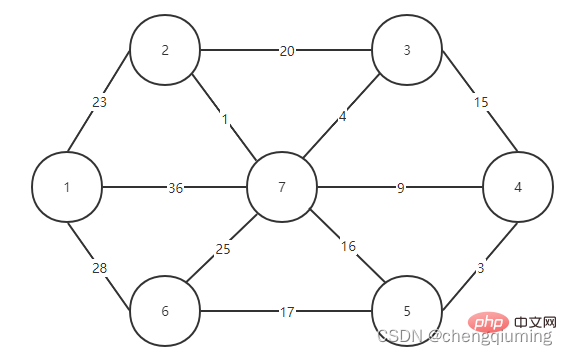
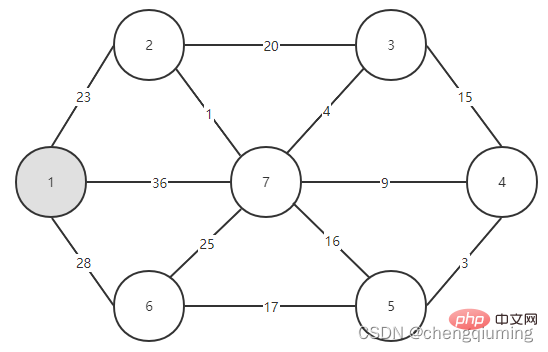
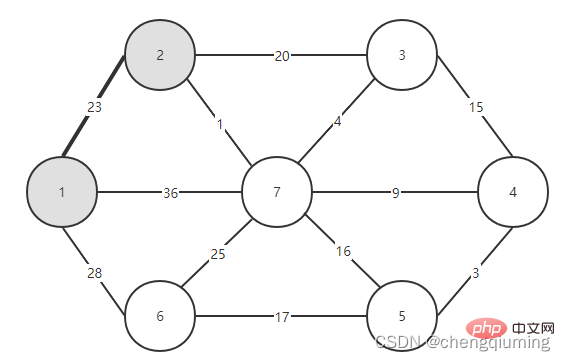

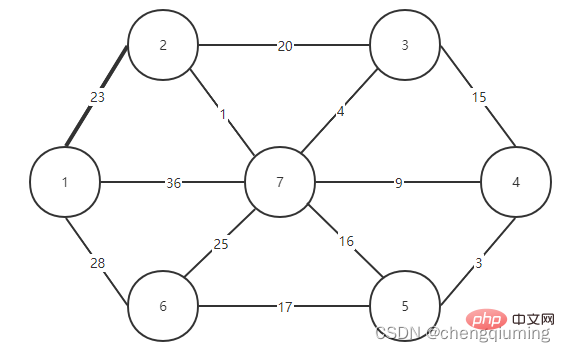

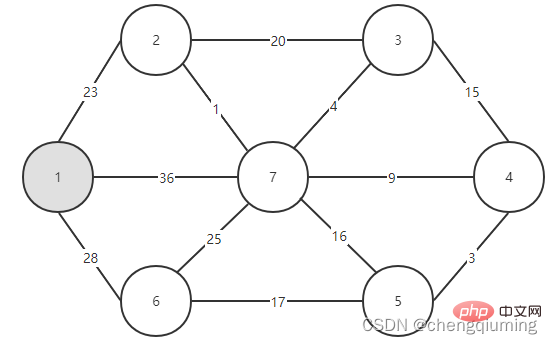
2 Find the node with the smallest lowcost, corresponding to t=2. The selected edges and nodes are as shown below.
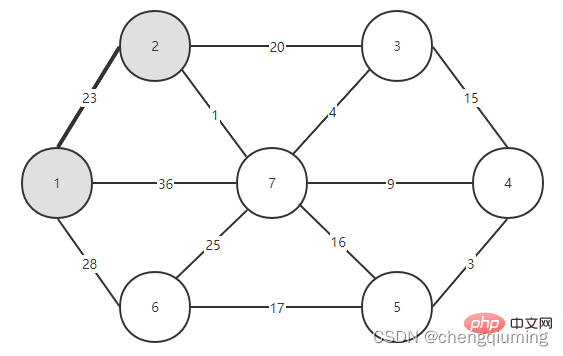
3 Add to set U. Add node t to the set U, U={1,2}, and update V-U={3,4,5,6,7}
4 at the same time. For each adjacent point j of t in the set V-U, it can be updated with the help of t. The adjacent points of node 2 are node 3 and node 7.
C[2][3]=20 C[2][7]=1 Updated closest[] and lowcost[] as shown below. The updated set is as shown below: 5 Find the node with the smallest lowcost, and the corresponding t= 7. The selected edges and nodes are as shown below. 6 Add to set U. Add node t to the set U, U={1,2,7}, and update V-U={3,4,5,6} 7 at the same time. For each adjacent point j of t in the set V-U, it can be updated with the help of t. The adjacent points of node 7 are nodes 3, 4, 5, and 6. The updated closest[] and lowcost[] are as shown below shown. The updated set is shown in the figure below: 16 at the same time. For each adjacent point j of t in the set V-U, it can be updated with the help of t. The neighbor of node 5 is node 6. C[5][6]=17 Updated The set is as shown below: 17 Find the node with the smallest lowcost, corresponding to t=6, and the selected edges and nodes are as shown below. 18 Add to set U. Add node t to the set U, U={1,2,3,4,5,6,7}, and update V-U={} 19 at the same time. For each adjacent point j of t in the set V-U, it can be updated with the help of t. Node 6 has no adjacent points in the set V-U. No need to update closest[] and lowcost[]. 20 The obtained minimum spanning tree is as follows. The sum of the weights of the minimum spanning tree is 57. Recommended study: " java video tutorial》 The above is the detailed content of The principle and implementation of Prime algorithm in Java (summary sharing). For more information, please follow other related articles on the PHP Chinese website!
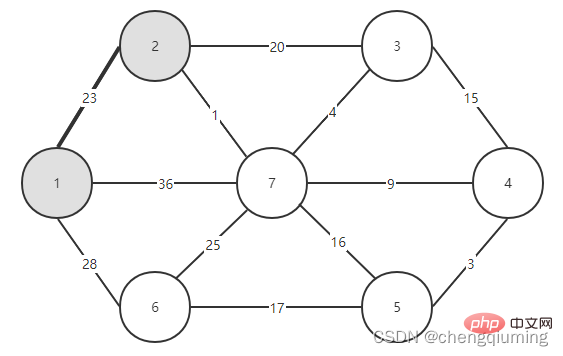
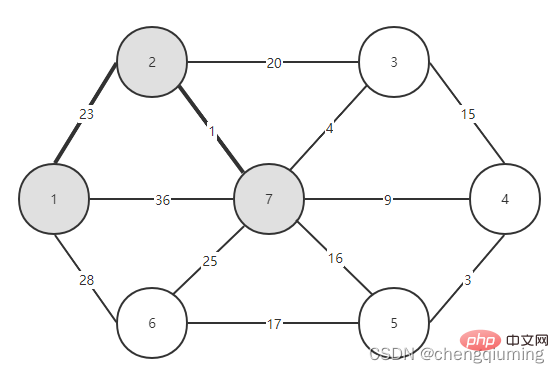

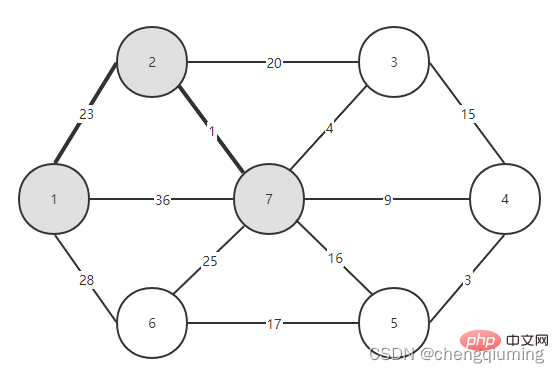
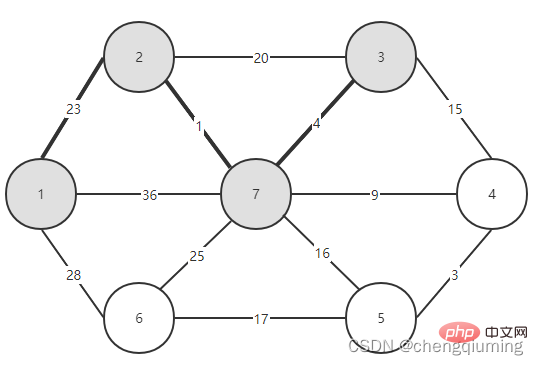
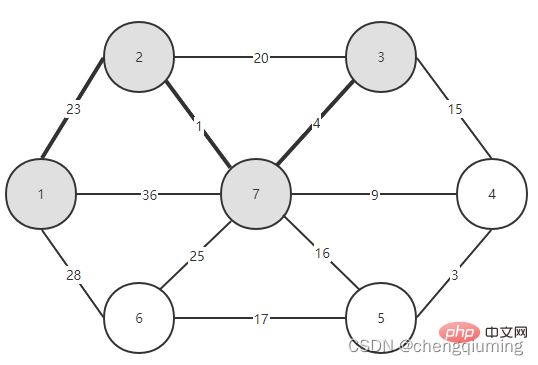


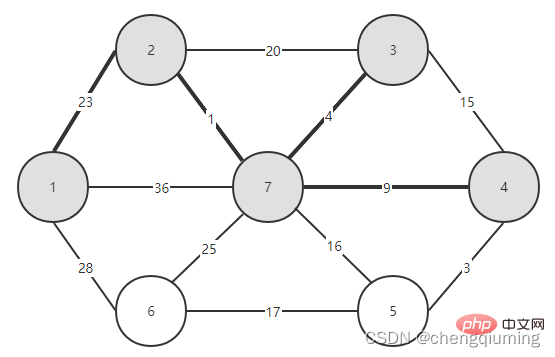 ##14 Find the node with the smallest lowcost, and the corresponding t= 5. The selected edges and nodes are as shown below.
##14 Find the node with the smallest lowcost, and the corresponding t= 5. The selected edges and nodes are as shown below. 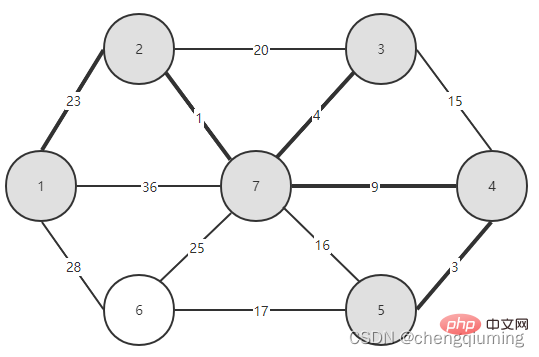 15 Add to set U. Add node t to the set U, U={1,2,3,4,5,7}, and update V-U={6}
15 Add to set U. Add node t to the set U, U={1,2,3,4,5,7}, and update V-U={6}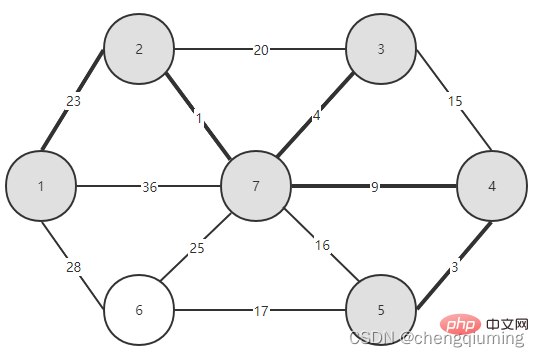
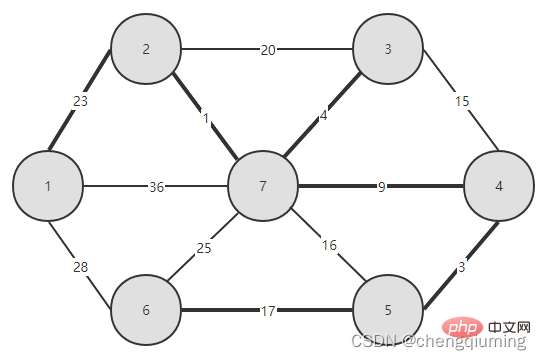
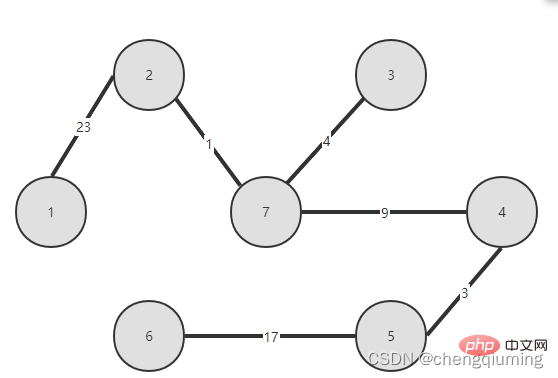
Prime algorithm implementation
1. The constructed graph
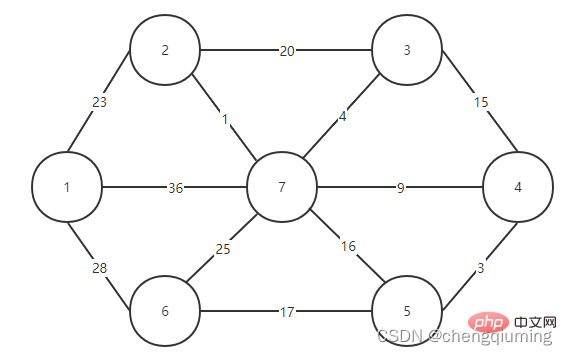
2. Code
package graph.prim;
import java.util.Scanner;
public class Prim {
static final int INF = 0x3f3f3f3f;
static final int N = 100;
// 如果s[i]=true,说明顶点i已加入U
static boolean s[] = new boolean[N];
static int c[][] = new int[N][N];
static int closest[] = new int[N];
static int lowcost[] = new int[N];
static void Prim(int n) {
// 初始时,集合中 U 只有一个元素,即顶点 1
s[1] = true;
for (int i = 1; i <= n; i++) {
if (i != 1) {
lowcost[i] = c[1][i];
closest[i] = 1;
s[i] = false;
} else
lowcost[i] = 0;
}
for (int i = 1; i < n; i++) {
int temp = INF;
int t = 1;
// 在集合中 V-u 中寻找距离集合U最近的顶点t
for (int j = 1; j <= n; j++) {
if (!s[j] && lowcost[j] < temp) {
t = j;
temp = lowcost[j];
}
}
if (t == 1)
break; // 找不到 t,跳出循环
s[t] = true; // 否则,t 加入集合U
for (int j = 1; j <= n; j++) { // 更新 lowcost 和 closest
if (!s[j] && c[t][j] < lowcost[j]) {
lowcost[j] = c[t][j];
closest[j] = t;
}
}
}
}
public static void main(String[] args) {
int n, m, u, v, w;
Scanner scanner = new Scanner(System.in);
n = scanner.nextInt();
m = scanner.nextInt();
int sumcost = 0;
for (int i = 1; i <= n; i++)
for (int j = 1; j <= n; j++)
c[i][j] = INF;
for (int i = 1; i <= m; i++) {
u = scanner.nextInt();
v = scanner.nextInt();
w = scanner.nextInt();
c[u][v] = c[v][u] = w;
}
Prim(n);
System.out.println("数组lowcost:");
for (int i = 1; i <= n; i++)
System.out.print(lowcost[i] + " ");
System.out.println();
for (int i = 1; i <= n; i++)
sumcost += lowcost[i];
System.out.println("最小的花费:" + sumcost);
}
}3. Test
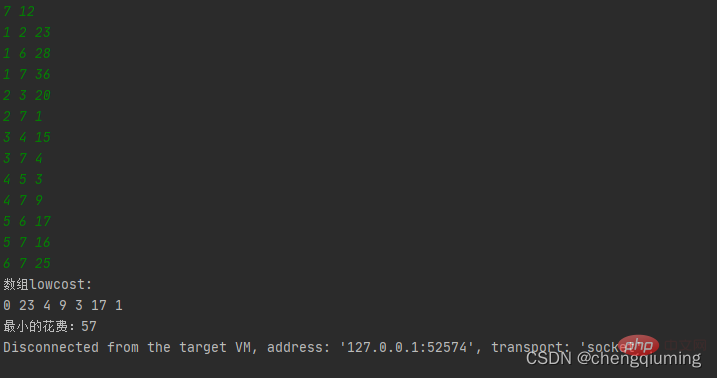

Hot AI Tools

Undresser.AI Undress
AI-powered app for creating realistic nude photos

AI Clothes Remover
Online AI tool for removing clothes from photos.

Undress AI Tool
Undress images for free

Clothoff.io
AI clothes remover

Video Face Swap
Swap faces in any video effortlessly with our completely free AI face swap tool!

Hot Article

Hot Tools

Notepad++7.3.1
Easy-to-use and free code editor

SublimeText3 Chinese version
Chinese version, very easy to use

Zend Studio 13.0.1
Powerful PHP integrated development environment

Dreamweaver CS6
Visual web development tools

SublimeText3 Mac version
God-level code editing software (SublimeText3)

Hot Topics
 1663
1663
 14
14
 1420
1420
 52
52
 1313
1313
 25
25
 1266
1266
 29
29
 1237
1237
 24
24
 Break or return from Java 8 stream forEach?
Feb 07, 2025 pm 12:09 PM
Break or return from Java 8 stream forEach?
Feb 07, 2025 pm 12:09 PM
Java 8 introduces the Stream API, providing a powerful and expressive way to process data collections. However, a common question when using Stream is: How to break or return from a forEach operation? Traditional loops allow for early interruption or return, but Stream's forEach method does not directly support this method. This article will explain the reasons and explore alternative methods for implementing premature termination in Stream processing systems. Further reading: Java Stream API improvements Understand Stream forEach The forEach method is a terminal operation that performs one operation on each element in the Stream. Its design intention is
 PHP: A Key Language for Web Development
Apr 13, 2025 am 12:08 AM
PHP: A Key Language for Web Development
Apr 13, 2025 am 12:08 AM
PHP is a scripting language widely used on the server side, especially suitable for web development. 1.PHP can embed HTML, process HTTP requests and responses, and supports a variety of databases. 2.PHP is used to generate dynamic web content, process form data, access databases, etc., with strong community support and open source resources. 3. PHP is an interpreted language, and the execution process includes lexical analysis, grammatical analysis, compilation and execution. 4.PHP can be combined with MySQL for advanced applications such as user registration systems. 5. When debugging PHP, you can use functions such as error_reporting() and var_dump(). 6. Optimize PHP code to use caching mechanisms, optimize database queries and use built-in functions. 7
 PHP vs. Python: Understanding the Differences
Apr 11, 2025 am 12:15 AM
PHP vs. Python: Understanding the Differences
Apr 11, 2025 am 12:15 AM
PHP and Python each have their own advantages, and the choice should be based on project requirements. 1.PHP is suitable for web development, with simple syntax and high execution efficiency. 2. Python is suitable for data science and machine learning, with concise syntax and rich libraries.
 PHP vs. Other Languages: A Comparison
Apr 13, 2025 am 12:19 AM
PHP vs. Other Languages: A Comparison
Apr 13, 2025 am 12:19 AM
PHP is suitable for web development, especially in rapid development and processing dynamic content, but is not good at data science and enterprise-level applications. Compared with Python, PHP has more advantages in web development, but is not as good as Python in the field of data science; compared with Java, PHP performs worse in enterprise-level applications, but is more flexible in web development; compared with JavaScript, PHP is more concise in back-end development, but is not as good as JavaScript in front-end development.
 PHP vs. Python: Core Features and Functionality
Apr 13, 2025 am 12:16 AM
PHP vs. Python: Core Features and Functionality
Apr 13, 2025 am 12:16 AM
PHP and Python each have their own advantages and are suitable for different scenarios. 1.PHP is suitable for web development and provides built-in web servers and rich function libraries. 2. Python is suitable for data science and machine learning, with concise syntax and a powerful standard library. When choosing, it should be decided based on project requirements.
 Java Program to Find the Volume of Capsule
Feb 07, 2025 am 11:37 AM
Java Program to Find the Volume of Capsule
Feb 07, 2025 am 11:37 AM
Capsules are three-dimensional geometric figures, composed of a cylinder and a hemisphere at both ends. The volume of the capsule can be calculated by adding the volume of the cylinder and the volume of the hemisphere at both ends. This tutorial will discuss how to calculate the volume of a given capsule in Java using different methods. Capsule volume formula The formula for capsule volume is as follows: Capsule volume = Cylindrical volume Volume Two hemisphere volume in, r: The radius of the hemisphere. h: The height of the cylinder (excluding the hemisphere). Example 1 enter Radius = 5 units Height = 10 units Output Volume = 1570.8 cubic units explain Calculate volume using formula: Volume = π × r2 × h (4
 PHP's Impact: Web Development and Beyond
Apr 18, 2025 am 12:10 AM
PHP's Impact: Web Development and Beyond
Apr 18, 2025 am 12:10 AM
PHPhassignificantlyimpactedwebdevelopmentandextendsbeyondit.1)ItpowersmajorplatformslikeWordPressandexcelsindatabaseinteractions.2)PHP'sadaptabilityallowsittoscaleforlargeapplicationsusingframeworkslikeLaravel.3)Beyondweb,PHPisusedincommand-linescrip
 PHP: The Foundation of Many Websites
Apr 13, 2025 am 12:07 AM
PHP: The Foundation of Many Websites
Apr 13, 2025 am 12:07 AM
The reasons why PHP is the preferred technology stack for many websites include its ease of use, strong community support, and widespread use. 1) Easy to learn and use, suitable for beginners. 2) Have a huge developer community and rich resources. 3) Widely used in WordPress, Drupal and other platforms. 4) Integrate tightly with web servers to simplify development deployment.



